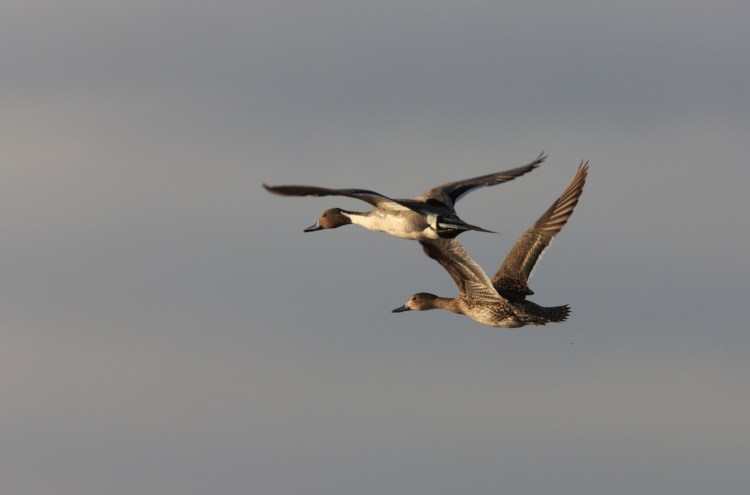Waterfowling is a fairly general term that can mean many things to many people. Most think of sitting in a blind, overlooking a spread of decoys, or perhaps paddling down a meandering stream jumping roosted ducks.
But many parts of the country have specialized techniques and tactics that are endemic to their respective regions.
Stuttgart, Arkansas, is the mallard capital of the world and there, the preferred method involves hunting flooded timber. Some may wade but most hunters reach their destination by boat, where they disembark into the knee- to waist-deep water surrounded by towering trees. Decoys are spread around, often haphazardly and platform seats for hunter and dog are attached to trees. As mallards wing overhead the hunters call loudly and often, simultaneously sloshing the water to create ripples and waves that add realism to their decoy spreads. Overhead shots are common as the birds whiffle down through the treetops.
One of my most relaxing and enjoyable hunts took place on Utah’s Great Salt Lake. After a hearty breakfast at a gentlemanly hour, we headed for the ramp where we launched and loaded into the airboats that would take us miles out onto the lake. There, we stepped out into knee-deep water and began setting out several hundred silhouette decoys in the soft mud. Then we settled into shallow layout boats as the airboats roared off for the nearest sand bar. The sun was well up, skies clear and temperatures warm, hardly ideal conditions for a duck hunt. But the ducks came, and came and came until all six shooters had limited out. We had a leisurely lunch on the bar while six more shooters repeated the process.
Locations like Currituck and Pamlico Sound inside North Carolina’s Outer Banks are legendary for diver duck hunting. There, waterfowlers motor out onto the big bays at a more typical predawn hour, headed for large wooden blinds sitting atop telephone-pole sized stilts. Dozens of decoys are set and rather than up, many of the shots are down, toward divers winging rapidly by the decoy spreads. Divers like canvasbacks, redheads and scaup are among the more common species but a daily bag often includes dabblers like gadwall, wigeon and pintails. The best hunting typically occurs late in the season, when cold weather and freezing inland waters push the birds farther south.
But not all waterfowl head far south for the winter, and January offers northern hunters on both coasts some of the best sea duck gunning of the year. This is not a sport for the casual waterfowler as it requires serious preparation and gear. Temperatures often plummet to a point where even the salt spray freezes on your clothing and gear, and the offshore waters can be hazardous to the unprepared. Decoys are strung out on long mother lines and most shooters hunt from the rocks, though a few bold lads will opt for layout boats. Shooting can be fast and furious when the birds are working well and handsome drake eiders weighing several pounds are a bucket list bird for many serious waterfowlers.
Flocks are also supplemented with a smattering of scoters and often random flocks of old squaw.
Some waterfowlers never get their feet wet. Early hunts for resident Canada geese and late hunts for migrants often take place in harvested agricultural fields.
Large spreads of silhouettes and/or full-bodied decoys are a requirement and hunters sit or lay in pit blinds, layout blinds or sometimes on the cold, hard ground. It’s a thrilling spectacle watching the big geese cup their wings and glide into the decoys.
One of my more memorable and interesting goose hunts took place along the St. Lawrence River in Quebec. For each hunt, our guide carried a roll of blank, white newspaper sheets. After bailing water out of our pit blinds and dressing the seats with hay, he would set to the task of fashioning each sheet into a three-dimensional rudimentary likeness of a snow goose. With several dozen “decoys” in place, we would settle into the blind and listen to the guide’s best vocal rendition of a snow goose. Flock after flock of birds passed, mostly high overhead but we were occasionally lucky enough to call in a few smaller groups or strays.
While they technically don’t qualify as waterfowl, I have also enjoyed the pleasure of pursuing rails. Hunting consists principally of poling shallow layout or sneak boats through flooded reeds and wild rice beds, hoping to flush the birds from their dense havens. Light gauge weapons are preferred as the birds are small and shots often close. It’s typically a very early season affair as the birds will be off and on their way south as soon as the first frosts kill emergent plants.
These are just some of the various waterfowling methods preferred in different regions, but they can be applied outside their home haunts. Newly flooded beaver bogs make an adequate substitute for Arkansas’ flooded timber. Green fields and even golf courses attract geese just as readily as a cut rice field in Texas. And divers occur on most any big body of water. If you’re looking for a change of pace, try something a little different this year.
Bob Humphrey is a freelance writer and registered Maine guide who lives in Pownal. He can be reached at:
bhunt@maine.rr.com
Comments are not available on this story.
Send questions/comments to the editors.


